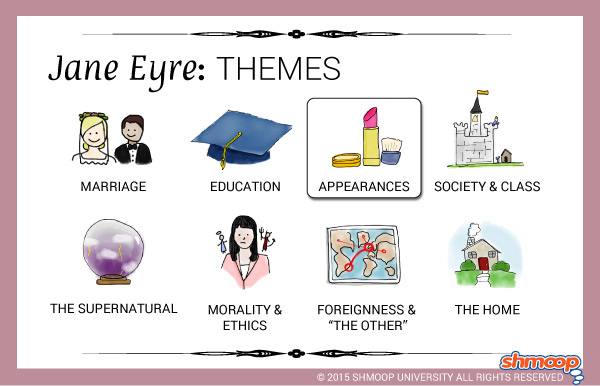 (Click the themes infographic to download.)
(Click the themes infographic to download.)
Appearances are almost always inversely related to the actual nature of the characters in Jane Eyre. Beautiful women turn out to be scheming harpies or selfish idiots; plain women turn out to have hidden depths of passion; ugly men aren’t actually ugly, but excitingly masculine in a harsh, craggy way.
Virtuous characters resist having their appearances radically changed or improved because doing so seems like pretending to be something they aren't. In contrast, characters who let themselves get obsessed with keeping external appearances plain and modest are distracted from deeper spiritual truths and often turn out to be hypocritical anyway.
Questions About Appearances
- Is Jane actually plain-looking? Think about this for a moment. Which characters claim that Jane is plain or ugly? Which characters describe her as beautiful, and when? (Think especially about Jane’s time at Moor House in Volume 3.)
- Why does the novel need to show us the plainly-dressed girls at Lowood and the dolled-up Brocklehurst women in Volume 1? What is the reader being prepared to understand later on?
- What does Bertha Mason actually look like? Whom does she look like—to which other character does Rochester compare her?
- Are appearances deceptive in Jane Eyre?
- Are there clear correspondences between moral nature and appearance in this novel or not?
Chew on This
Jane’s claim that she is a "plain, Quakerish governess" is actually somewhat misleading; her attempt to hide her beauty from the reader demonstrates her belief that beauty and morality are mutually exclusive.
Although other characters occasionally claim that Jane is beautiful, her beauty is always related to her mood or her character; it’s an "inner beauty" that the reader can only understand because Jane is a "plain, Quakerish governess" on the outside.